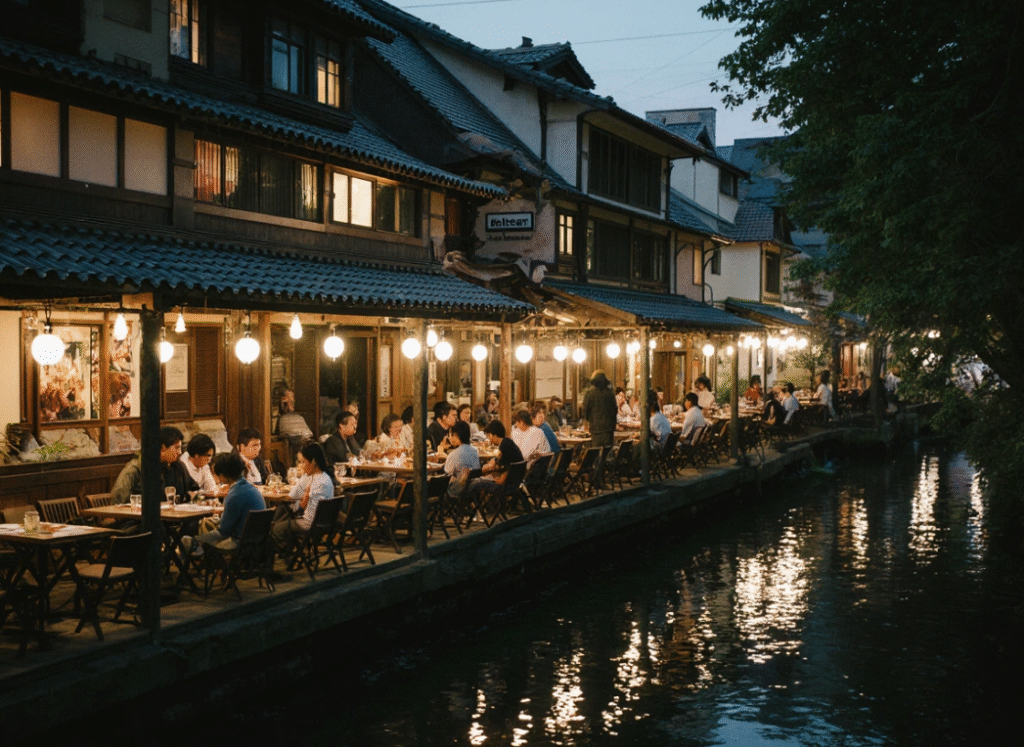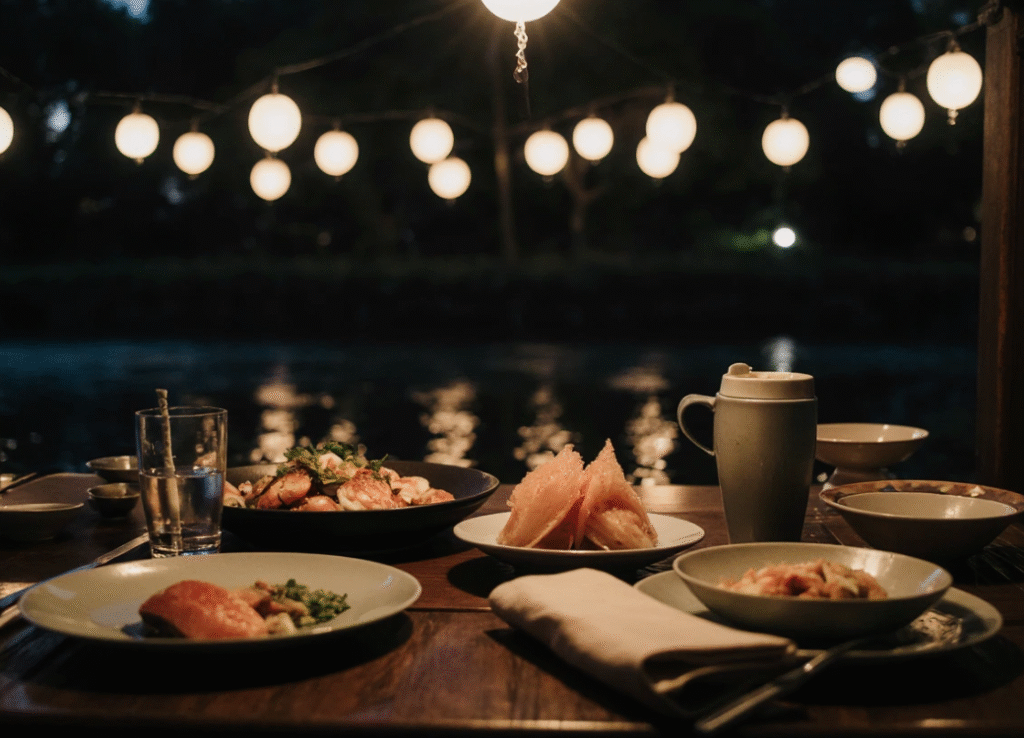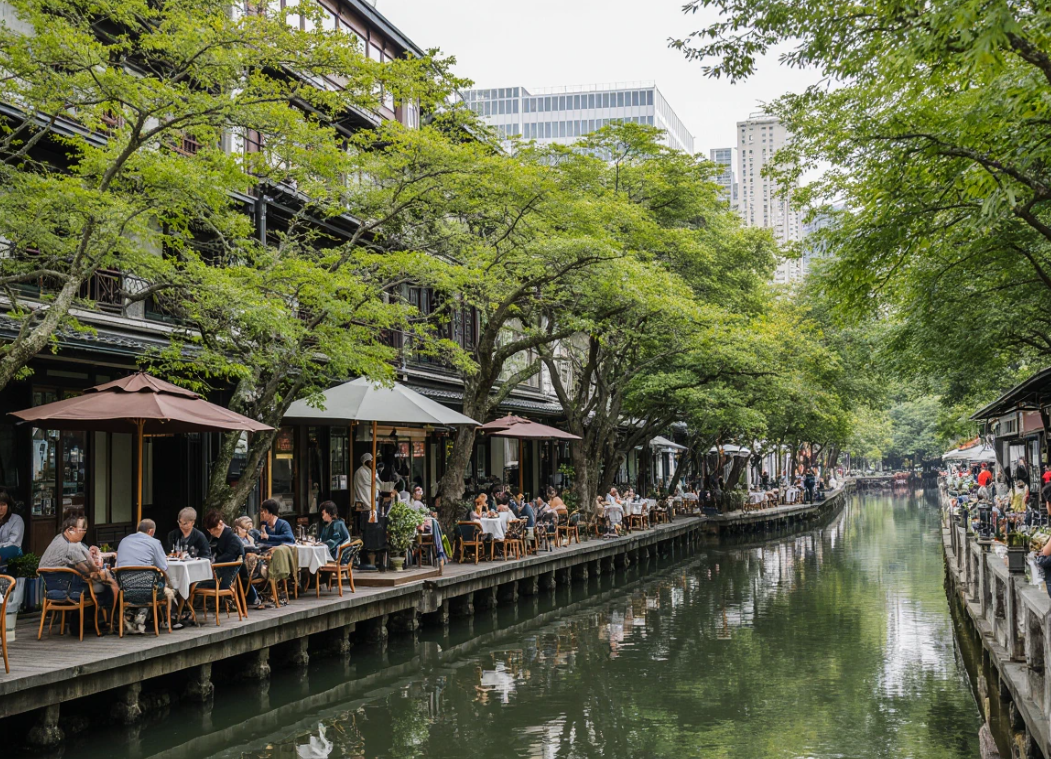Summer in Kyoto brings Kawayuka: wooden platforms suspended over the Kamo River where you eat kaiseki while cool air rises through floorboards. This riverside dining Kyoto tradition runs from May 1st to September 30th, with over forty Pontocho restaurants building temporary decks that hover 2 meters above rushing water, dropping temperatures 5-7°C below street level.
More about Pontocho:
What Makes Riverside Dining Pontocho Unique?

Kawayuka platforms extend over rivers on metal scaffolding, creating dining space directly above flowing water. The river’s cooling effect makes it comfortable to eat outside when Kyoto hits 35°C (95°F). Wooden floorboards sit 2-3 centimeters apart—you see water rushing underneath throughout your meal. If you’re wearing a dress or carrying small items, know this: gaps are wide enough for phones and glasses to slip through into the river.
These Kamo River Yuka platforms exist for exactly 153 days annually. Restaurants charge premium prices: dinner starts at ¥8,000 ($55) and reaches ¥25,000 ($170) for high-end kaiseki. You’re paying for a structure that operates only during Kawayuka season, not year-round restaurant overhead.
From Struggling District to Instagram Destination
In the early 2000s, Pontocho was declining. The narrow alley (3-4 meters wide, 500 meters long) made it inconvenient compared to modern districts. The Kyoto Tourism Board invested in infrastructure improvements and established quality standards for Nōryō-yuka platforms. Social media after 2010 accelerated everything—lantern-lit alleys and riverside dining became viral content. By 2015, Kawayuka Pontocho transformed from a local dining strip to an international destination where restaurants maintain 80-90% occupancy during the season.
The district chose tradition over modernization. That choice created today’s reality: overwhelming demand and difficult booking for Pontocho summer terraces.
Why Kawayuka Reservation Tips Matter: Competition for Limited Seats
Pontocho has approximately 40 Kawayuka restaurants with 12-16 seats each—roughly 500-600 total seats per evening. Kyoto receives 50 million annual visitors, with 30% traveling in summer. Even 1% trying to book means 150,000 people competing for 76,500 seat-nights across the season. Walk-in availability is zero during June-August weekends.
High-end establishments accept bookings 2-3 months ahead and fill within 48 hours. Mid-range restaurants open reservations 4-6 weeks out. By the time you arrive thinking you’ll “figure it out locally,” everything is booked.
Three Price Tiers for Kawayuka Dining
Budget Kawayuka (¥3,500-6,000)
Simplified 5-7 course meals with 60-75 minute time limits. Tables cramped at 60-70cm spacing. Food is decent but unremarkable—you’re paying for platform access. Restaurants like Pontocho Fujita and Kushi Kura fall in this range.
The compromise: rushed service, tight seating, and you’ll feel pressured to leave. Choose this only if your primary goal is experiencing the atmosphere on a tight budget.
Mid-Range Kawayuka (¥8,000-12,000)
The sweet spot. Eight to ten courses including quality sashimi, grilled fish, seasonal vegetables, proper Kawayuka seating spacing, and no time limits. Pontocho Robata and Pontocho Ayumi deliver solid experiences here. The food is genuinely good and represents Kyoto’s culinary traditions properly. Best balance between cost and quality for most travelers.
Premium Kawayuka (¥15,000-25,000+)
Twelve to fifteen exquisitely prepared courses using premium ingredients: wild-caught regional fish, heritage vegetables, aged beef. Pontocho Misoguigawa exemplifies this tier. Meals stretch 2.5-3 hours. Worth it only if you can distinguish between good and exceptional ingredients—otherwise you’re paying for subtleties you won’t notice.
| Feature | Budget | Mid-Range | Premium |
| Courses | 5-7 | 8-10 | 12-15 |
| Time Limit | 60-75 min | None | None |
| Spacing | Cramped | Comfortable | Spacious |
| Booking Window | 2-3 weeks | 4-6 weeks | 2-3 months |
| Best For | Atmosphere only | Balanced experience | Food enthusiasts |
How to Book Kawayuka: Proven Strategies

Hotel Concierge (60-70% Success Rate)
Contact your hotel 4-6 weeks before arrival. Mid-range and upscale Kyoto hotels maintain restaurant relationships and can secure Kawayuka reservations that appear fully booked. Hotels guarantee guest payment and showing up—this matters to restaurants dealing with 30% no-show rates from direct foreign bookings.
Give your concierge: preferred date, backup date, and maximum budget per person including drinks. Let them choose the restaurant—they know which places have availability and deliver quality.
“About 15-20% of kawayuka seats are sold through hotel concierge services who maintain relationships with restaurants. Your concierge can often secure reservations that are ‘impossible’ for walk-ins because hotels guarantee guests will show up.”
TableCheck/Tabelog Apps (30-40% Success Rate)
Download TableCheck (tablecheckapp.com) or Tabelog (tabelog.com/en), create accounts, input credit card for guarantee. Search “Pontocho kawayuka” during your target month. Listings show fully booked because inventory disappears within hours. Check daily starting exactly when booking windows open. Set phone reminders. This works best for weekday dinners in May or September.
Tour Operators (85-90% Success Rate, Highest Cost)
Voyagin (govoyagin.com) and Viator (viator.com) sell packages at ¥12,000-18,000 per person—a ¥3,000-5,000 markup over direct booking. You’re paying for guaranteed seats. These operators buy reservation blocks months ahead. If your time is worth more than spending 3-4 hours attempting bookings that might fail anyway, the convenience fee is reasonable.
When Is Kawayuka Season: Complete Monthly Guide
Understanding Kawayuka season dates helps you plan strategically. The Noryo-yuka Kyoto tradition operates precisely from May to September each year, but conditions vary dramatically by month.
May (Best Weather-to-Crowd Ratio)
Temperatures 20-26°C, Kamo River runs high from spring melt, moderate crowds. Booking difficulty: Medium. Best month for comfortable weather without excessive humidity. Early sunset (6:30-6:45 PM) means you watch daylight transition to lantern-lit evening during your meal.
June-August (Peak Season, Worst Weather)
June brings the rainy season—40-50% chance of rain. Restaurants install vinyl rain curtains that maintain platform access but eliminate open-air appeal. July-August hit 32-36°C with 70-80% humidity. Booking difficulty: Extreme. Quality becomes variable as restaurants rush to serve maximum covers during peak Kawayuka season.
September (Secret Sweet Spot)
Temperatures 23-29°C, humidity drops, crowds thin. Booking difficulty: Medium-Low. Many restaurants have weekday availability 2-3 weeks out. The catch: some restaurants close platforms early (mid-September) if the weather cools. Call ahead to confirm platform status. Optimal month for first-time diners who want to enjoy the experience rather than just check a box.
Kamo River Dining: Traditional Kaiseki Courses
Kaiseki follows a specific course structure. Mid-range Kawayuka serves simplified 8-10 course versions:
- Sakizuke (Appetizer): Tiny portion of pickled vegetables or tofu. Don’t fill up—this stimulates appetite.
- Owan (Soup): Clear broth with seasonal ingredients. The simplicity hides 6-8 hours of dashi preparation.
- Mukozuke (Sashimi): Where ingredient quality becomes obvious. Three to four fish types: white fish, red fish, possibly seasonal ayu (sweetfish).
- Yakimono (Grilled): Usually whole fish, head-on. You’re expected to eat everything except bones—yes, including crispy tail and fins.
- Nimono (Simmered): Vegetables and protein in seasoned broth. Comfort food dressed elegantly.
- Agemono (Fried): Tempura—4-6 pieces of shrimp, fish, and seasonal vegetables. Light, crispy batter.
- Shokuji (Rice): Signals meal ending. Plain rice, miso soup, pickles. Designed to ground you after previous courses.
- Mizugashi (Dessert): Simple fruit or light sweet. Slice of melon, lychee, or mochi. Your palate needs refreshment, not complexity.
For dietary restrictions: Vegetarian options require 48 hours advance notice. Vegan kaiseki is extremely difficult—no restaurants accommodate this. Communicate restrictions when booking, not when you arrive.
Behind the Beauty: What Instagram Doesn’t Show About Kawayuka
The platforms wobble. When neighboring diners shift weight or stand up, you feel movement through the wooden structure. This is normal and safe—platforms meet strict engineering standards—but if you’re anxious about heights, this sensation distracts you throughout the meal.
Insects are part of the deal. Mosquitoes, small flies, and moths join your dinner. Most restaurants provide citronella candles or electronic repellent (60-70% effective). Bring your own mosquito repellent if you react badly to bites.

River smell varies. After heavy rain, Kamogawa smells earthy. During dry spells, algae on rocks creates organic smell. Most evenings it’s fine, but occasionally it’s noticeable enough to affect your riverside dining Kyoto experience.
Smoke from nearby platforms. Outdoor smoking is legal. When other diners smoke between courses, wind carries it to your table. Only solution: book restaurants that advertise as non-smoking (minority in Pontocho).
Cultural Heritage: Kawayuka Construction Techniques
Platform construction employs traditional carpentry techniques dating to the Edo period. No nails are used in Kawayuka construction—joints rely on precise wood fitting that allows seasonal expansion and contraction. The exact platform height above water is regulated by Kyoto City ordinances to prevent flooding damage and ensure safety. Every restaurant must submit engineering plans annually.
Pontocho’s name comes from Portuguese “ponto” (point/tip) reflecting 16th-century foreign influence when Portuguese traders frequented the area.
The tradition nearly died in the 1970s when only eight restaurants maintained platforms. Rising construction costs and declining interest almost ended the practice. The Tourism Board’s 2000s intervention saved it.
Restaurants pay the city annual fees of ¥150,000-300,000 ($1,000-2,000) for river usage rights, separate from construction and maintenance costs.
When Kawayuka Disappoints: Setting Realistic Expectations
- If you’re a serious food enthusiast: Unless booking a premium tier (¥15,000+), the food won’t impress you. You’ll find better kaiseki at non-Kawayuka restaurants for the same price. These charge premiums for atmosphere, not culinary excellence.
- If you have mobility issues: Getting to platforms requires navigating steep, narrow stairs (12-15 steps at 40-45 degree angles). Once seated, the wobbling sensation and visible water below creates ongoing anxiety for some people.
- If traveling with young children: Most restaurants request no young children under 8-10. Floor gaps, river proximity, multi-hour meal duration, and formal atmosphere make this unsuitable for kids who can’t sit still.
- If your budget is tight: After meal cost, drinks, service charge, and transportation, you’re spending ¥12,000-15,000 ($80-100) per person minimum. If that’s 20%+ of your daily Japan budget, dozens of other Kyoto experiences deliver more satisfaction per yen.
The Three Most Common Kawayuka Mistakes
Mistake 1: Booking June-August Without Checking Weather
Tourists plan around work schedules, landing in summer assuming perfect outdoor dining weather. June is the rainy season with a 40-50% chance of rain—plastic curtains eliminate open-air appeal. August brings oppressive humidity that makes the meal uncomfortable. Cost: You paid ¥15,000 for atmospheric experience but received a compromised version worth ¥8,000. Lost value: ¥7,000 plus disappointment.
Mistake 2: Choosing Budget Tier Expecting Mid-Range Quality
Budget-conscious travelers see ¥3,500 options and think “I’ll save ¥5,000 and get a similar experience.” The budget tier delivers 40% of the experience, not 80%. Time limits rush you through courses. Tables crammed together. Food quality drops dramatically—frozen fish, assembly-line preparation. Cost: The ¥5,000 you “saved” bought disappointment. Mid-range at ¥8,000 delivers experience worth ¥10,000. That’s the most expensive “savings” you’ll make in Japan.
Mistake 3: Trying to Book After Arriving in Kyoto
Travelers want flexibility, so they wait to book after arrival. By then, everything is booked. You’ll spend 3-4 hours calling restaurants with Google Translate, getting rejected, and ultimately paying ¥3,000-5,000 markups through tour operators. Cost: 4 hours of precious Kyoto time + ¥5,000 convenience fee + degraded experience. All avoidable by booking 4-6 weeks ahead.
“Kawayuka is like theater tickets—you book a specific performance at a specific time. The show doesn’t change for you. If you want flexibility to modify menus, change dates, or make last-minute decisions, kawayuka is the wrong choice. It works best for travelers who commit to plans weeks in advance.”
Cost of Kawayuka Dining: Hidden Expenses Beyond Menu Prices

Restaurants charge menu price plus 10% service fee plus 8% consumption tax. A ¥10,000 menu becomes ¥11,800. Drinks add ¥2,000-3,500 per person (beer ¥600-800, sake ¥800-1,500). Transportation to Pontocho and back runs ¥2,000-3,000 by taxi from popular tourist areas, or ¥1,000-1,500 by bus requiring transfers.
Kaiseki portions are elegant but controlled. You’ll feel satisfied immediately but genuinely hungry again 90-120 minutes later. Many diners buy convenience store snacks (¥500-1,000) afterward.
Total realistic cost of Kawayuka dining for mid-range experience: ¥15,000-18,000 per person ($100-120). That’s double what tourists expect from ¥8,000 menu prices.
Practical Pre-Dinner Details: Location and Timing
- Location: Pontocho runs parallel to the Kamo River between Shijo-dori and Sanjo Street. Nearest station: Gion-Shiyomachi Station (Keihan Line) or Kawaramachi Station (Hankyu Line), both 5-minute walk.
- What to wear: Casual but neat. Men: collared shirt and long pants. Women: casual dress or nice top. Avoid flip-flops, tank tops, and athletic wear. Bring a light layer—river air cools after sunset even in summer.
- Timing: Leave your hotel 20 minutes earlier than Google Maps suggests. Pontocho is deliberately hard to find. You’ll walk past the entrance twice. Better to arrive early than be late and stressed.
- Payment: Most restaurants accept credit cards, but 20-30% remain cash-only. Call ahead to confirm. 7-Eleven with an international ATM is two blocks away (¥220 withdrawal fee).
- Best reservation time: Book for 6:30-7:00 PM. Earlier lets you watch the sunset transition. Later (7:30-8:00 PM) means you dine in darkness throughout.
Case Study: Strategic Booking for September Kawayuka
Situation: Sarah planned a Kyoto trip for mid-July, tried booking in June (6 weeks ahead). Every restaurant she contacted was fully booked. Tour operators quoted ¥16,000 per person—¥6,000 more than direct booking.
Action: She shifted her Kyoto dates to mid-September and contacted her hotel concierge 5 weeks before arrival with a preferred date and ¥10,000 budget.
Result: Concierge secured reservation at Pontocho Robata for ¥9,500 per person within 24 hours. September temperatures were 6°C cooler than July would have been. No rain. The restaurant wasn’t rushed with peak-season crowds, so service was more attentive. Total savings: ¥6,500 per person plus dramatically better experience. Her flexibility on dates converted a stressful, overpriced situation into exactly what she wanted at fair price.
Best Kawayuka Restaurants: Three Alternative Options
- Kibune Village Kawadoko (30 minutes north): Platforms sit directly on river rocks, closer to water. Temperatures run 3-4°C cooler due to mountain elevation. Prices ¥4,000-10,000, averaging 20-30% less than Pontocho. Booking difficulty is moderate. Trade-off: 90 minutes round-trip travel time. Among the best Kawayuka restaurants for budget-conscious travelers. Learn more: Kibune Tourism Association (kibune.jp/en).
- Standard Kamogawa Riverbank Dining: Ground-level outdoor tables directly on the riverbank. Available year-round, no premium pricing, no advance booking needed. You lose suspended-over-water drama but keep 70% of the atmosphere. Prices ¥3,000-6,000.
- Rooftop Beer Gardens: During Kawayuka season from May to September, department stores and hotels open rooftop beer gardens with all-you-can-eat-and-drink at ¥3,000-4,500 for 90-120 minutes. Walk-in friendly. Different cultural lens but equally authentic to modern Japanese summer traditions.
Making Kawayuka Worth It: Understanding the True Value
The Kawayuka experience frustrates travelers expecting restaurant experiences to center on food. The meal is important but secondary. You’re paying for atmospheric experience: lantern-lit alley, elevated platform, rushing river, summer evening air. Food enhances this but doesn’t define it.

Don’t compare your Kawayuka dinner to your best meal in Japan. Compare it to your most atmospheric evening. Did you feel transported? Did the setting create memorable moments? Those are the correct metrics.
Treat this as immersive theater with food. If you approach expecting Michelin-quality cuisine at mid-range prices, you’ll leave disappointed. If you approach it as a cultural experience where good food accompanies an exceptional atmosphere, you’ll understand exactly what you paid for.
Planning Your Visit: Essential Kawayuka Information
The riverside dining Pontocho tradition represents one of Kyoto’s most sought-after summer experiences. Understanding when is Kawayuka season—precisely May to September—helps you plan strategically. Peak demand occurs during July and August when Pontocho summer terraces attract maximum crowds.
Smart travelers target May or September for optimal balance of weather, availability, and authentic experience without overwhelming tourist presence. Early May offers cherry blossom afterglow and comfortable temperatures. Late September provides autumn preview with reliable weather. Mid-season months deliver a peak atmosphere but require advanced planning and higher budgets.
The Kamo River Yuka platforms create a unique microclimate where temperatures drop 5-7°C below street level, making summer dining comfortable when downtown Kyoto swelters at 35°C. This natural cooling effect, combined with traditional architecture and kaiseki cuisine, creates the distinctive character that makes riverside dining Kyoto famous worldwide.
Further reading: Kyoto Official Travel Guide (kyoto.travel/en), Japan Guide Kawayuka Overview (japan-guide.com/e/e3906.html), Pontocho preservation efforts documented by Kyoto City Tourism Board (kyokanko.or.jp/en).
